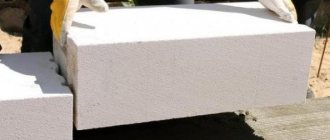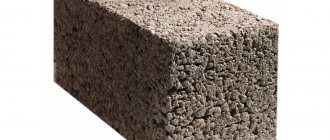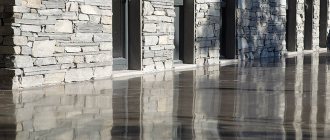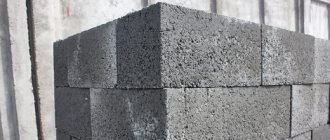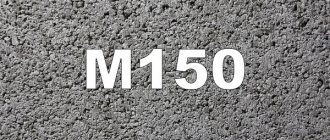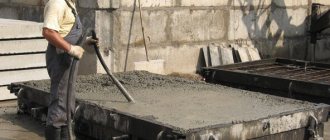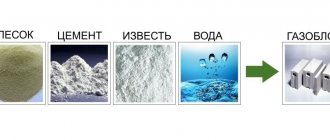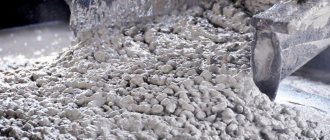Beton-House.com
Website about concrete: construction, characteristics, design. We combine the experience of professionals and private craftsmen in one place
Appearance of the material
Concrete is a material that has remained one of the main ones in the construction industry for decades. It is used almost everywhere, from the construction of roads, foundations and ending with the insulation of buildings.
So what does the scope of its application mainly depend on? What is it? This is what we will talk about in this article. Or, more precisely, about the most important property of the above material. Density of concrete: what is it and what does the numerical quality indicator depend on.
- List of main factors, methods for increasing value
- Control method in accordance with GOST
What is the material
It consists of 4 main components: cement, water, large and small aggregates. The properties of the future solution and products made from it depend on the proportions of these fillers.
Let's look at what qualities are characteristic of it and what function they perform.
Compound
Key indicators and characteristics
Let's use the table.
Basic performance properties:
| Name | Comments |
| Compressive strength | This is one of the main indicators. Depending on it, the class is set. In accordance with SNiP, the indicator is designated by the Latin letter B and indicates how much pressure in megapascals the material can withstand. In addition to the class, the characteristic is also specified by the grade of the material, which indicates the compressive strength with the calculation of the load in kg/cm2. The relationship between these coefficients will be discussed below. |
| Workability | In accordance with GOST 7473-2010, the following are distinguished:
In terms of workability, the grade has its own standard of rigidity and cone settlement. The latter indicates the level of plasticity. This indicator is extremely important when concreting. For pumping, mixtures characterized by a value of at least P4 are used. |
| Frost resistance | It is designated by the letter F and indicates how many freezing and thawing cycles the material can withstand. Numbered with numbers from 50 to 1000. |
| Waterproof | Indicates how much water pressure the sample can withstand. It is designated W and numbered from 2 to 20. Water permeability directly depends on the level of porosity. |
| Density grade | The brand is measured in kg/m3. It indicates their load-bearing capacity and ability to withstand certain loads. Brands are designated - d. |
Some characteristics
Now let's take a closer look at the dependence of the grade on workability, the standard of rigidity and the draft of the cone.
Workability grades:
| Brand | Hardness standard | Cone draft |
| Super-hard mixture (SZh3) | Over 100 | — |
| Super-hard mixture (SZh2) | 50-100 | — |
| Super-hard mixture (SZh1) | Less than 50 | — |
| Hard 4 | 30-60 | — |
| Hard 3 | 20-30 | — |
| Hard 2 | 10-20 | — |
| Hard 1 | Less than 10 | — |
| Mobile 1 | Less than 4 | 1-5 |
| Movable 2 | — | 5-9 |
| Mobile 3 | — | 10-15 |
| Mobile 4 | — | 15-20 |
| Movable 5 | — | More than 20 |
Surely, many will have a question: how to determine this cone shrinkage? This is done quite simply. To do this you will need a small amount of the mixture and the cone itself.
The instructions look like this:
- It is placed on a flat surface and filled with the mixture in several approaches.
- The process is accompanied by bayoneting and shaking to better compact the solution.
- Once completely filled, the cone is slowly raised. The concrete flows out and forms something like a slide.
- The cone is placed nearby and the distance to which it has descended is measured.
The higher the volumetric weight of the solution, the smaller the cone sediment will be, which you see in the photo.
Cone draft
Types of concrete and scope of application
Now let's figure out what types of concrete there are and what their scope of application is. The types are dictated by GOST 25192-2012 and GOST 7473-2010. In accordance with this technical documentation, the following is distinguished: classification by purpose.
Depending on the purpose, there are:
- Conventional (construction of civil and industrial buildings);
- Special: heat-insulating, hydraulic, decorative, road;
- Special purpose: sound-absorbing, heat-resistant, chemical-resistant.
In accordance with the main type of binder, there are:
- Cement;
- Slag-alkali;
- Silicate;
- Asphalt concrete;
- Plaster;
- Plastic concrete and others.
Asphalt concrete, strength up to b25
Depending on the type of filler, the material can be:
- On porous aggregate;
- On dense aggregate;
- On a special filler.
Structure.
In accordance with it, they distinguish:
- with a dense structure;
- Large porous structure;
- Cellular structure;
- Porous.
Depending on the hardening method:
- Autoclaved, hardening when processed in special machines - autoclaves, under high pressure and temperature;
- Non-autoclave, which is characterized by a natural hardening method;
- Hardening under conditions of processing at atmospheric pressure.
Another classification is based on binder and aggregates.
In accordance with this, the material is divided into:
- Commodity;
- Fat;
- Skinny.
So:
- Ready-mix concrete has a standard formula for the ratio of aggregate and main binder.
- Fat is characterized by a higher content of binder and a lower amount of coarse aggregate.
- Skinny differs in the opposite way from fat, that is, it has a high content of aggregate and a low content of the main binder.
Density classification distinguishes:
- Particularly heavy (grade - over 2500). They have the greatest significance. They are used in the construction of special objects. For example, during the construction of structures whose purpose is to prevent the penetration of radiation.
- Heavy (brand – 2100-2500). It is made mainly from cement, steel shavings and quartz. It is used for the construction of extra-strong foundations and foundations of heavy structures.
On a note! The density of reinforced concrete in kg m3 is quite high, due to which it can withstand significant loads. The value of reinforced concrete depends, first of all, on the composition of the components and the proportions of raw materials.
- Lightweight (grades from 1800 to 2200). The main filler is crushed stone. Its main advantage is its low weight. Used in the construction of complexes, walls and foundations of buildings.
- Lungs. These include, first of all, cellular ones. They are divided into structural and structural-thermal insulating. The density of the cellular type can vary from 500 to 1800.
The brand determines the scope of its application. Products characterized by an indicator of 500-600 kg m3 are the most popular among private developers. They are used for the construction of walls and partitions of buildings up to 3 floors high.
- Particularly light (volumetric weight - less than 500). These are low-density foam and aerated concrete. The material is used as thermal insulation, since it cannot withstand any significant loads.
Types depending on manufacturing technology:
| Name | The main difference in production, the value of volumetric weight |
| Rolled | A rigid material that is compacted using, for example, a vibratory roller. |
| Self-sealing | It is distinguished by its ability to compact under the influence of its weight. |
| Extra hard | Obtained from a mixture whose cone slump and hardness are not measured, it can have a strength of 25-40 |
| Shotcrete | It is applied to the surface pneumatically and is fine-grained. The density of shotcrete is its advantage; it has a wide range of applications. The material is especially distinguished by its low water absorption coefficient and good adhesion to the base, therefore it is used as waterproofing coatings. |
| Cast | Material whose cone draft is no more than 20 cm. |
| Roller molding | As the name implies, it is formed by the action of rollers, the material is distinguished by its rigidity |
| Autoclave curing method | It is manufactured in a factory and is processed at the last stage of production in an autoclave. |
| Vacuumed | It differs in that before the solution hardens, part of the liquid is removed using the vacuum method. |
| Underwater laying | Places under water. |
Shotcrete,
How to influence density (volumetric weight)
To obtain the optimal density of concrete in kg/m3, you can use any of the existing methods:
- Adding filler with finer fractions allows you to reduce the number of voids and prevent the appearance of a layer of air. I advise you to look at how to mix concrete correctly.
- Decrease in quantitative water content. However, when mixing the concrete mixture, it is necessary to ensure its fluidity. If the solution turns out to be too thick, it significantly complicates the work. In particular, with non-standard designs and large volumes.
- Manual or mechanical compaction - after pouring the solution, you need to make several holes in it for the unhindered release of air and water to the surface. You can use any convenient tool, for example, a shovel or a vibrator.
- Artificial heating promotes faster evaporation of water, as a result of an increase in the mass and specific gravity of hardened concrete.
- Choose an expanding or non-shrinking agent to obtain cement with minimal porosity but high quality.
- The addition of a plasticizer in the composition helps reduce the amount of liquid at the same fluidity, which helps increase density.
- Vacuuming is a method that can only be implemented on an industrial scale.
